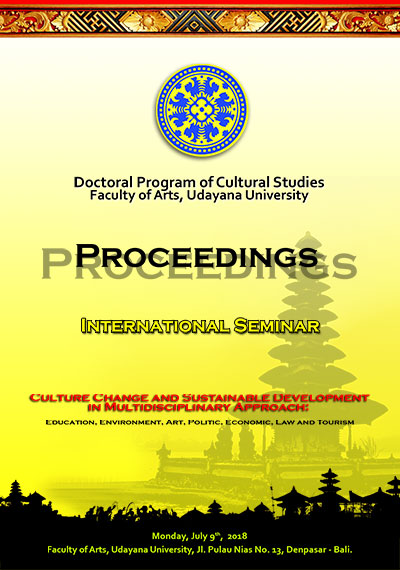THE AESTHETIC MEANINGS OF GAJAH OLING BATIK WORN FOR SEBLANG DANCE RITUAL PERFORMED BY OSING TRIBE IN BANYUWANGI
Abstract
Gajah Oling is a special batik from Banyuwangi district which is still believed by the Using tribe in Banyuwangi as a distinctive and sacred motif used in various existing custom rituals and dances. One of the traditional rituals that still uses the batik motif is Seblang dance ritual performed in two places; Olehsari and Bakungan village. In Olehsari village, Seblang is performed by young girls, meanwhile in Bakungan village Seblang is performed by elderly women. Gajah Oling batik is used in traditional Seblang ritual as along cloth (or sewek) and used as scarf for the dancers, on panekebfor the singers and the handler; even on headbands or udengas used by the inviting handler and gamelan musicians. The aesthetic meanings here will be analyzed based on their meanings on the motif used by Seblang dancers in both Bakungan or Olehsari village on its long clothes, scarfs, and headbands. This article aims at describing the meaning of aesthetic interpretation on the elaboration of the shape, color, line, position, and size on the motif of Gajah Oling batik based on its main motifs, fringe motifs and isen-isen (ornaments). The results related to the aesthetic meanings of the traditional Seblang ritual will also be described in depth.
Downloads
References
Sutarto, Ayu dan Sudikan, Setya Yuwana. 2008. Pemetaan Kebudayaan di Propinsi Jawa Timur. Jember: Biru Mental Spiritual Jatim dan Kompyawisda Jatim.
Tanpa Nama. 2009. Gendhing-gendhing Mantra Seblang Olehsari. Banyuwangi: Dinas Kebudayaan dan Periwisata Kabupaten Banyuwangi.
Heriyawati, Yanti. 2016. Seni Pertunjukan dan Ritual. Yogyakarta: Ombak Van Der Hoop. 1949. Ragam-ragam Perhiasan Indonesia. Jakarta: Koninklijk Bataviaasch Genootshap Van Kunsten En Wetenschappen.





